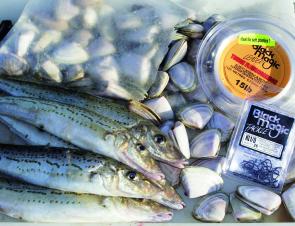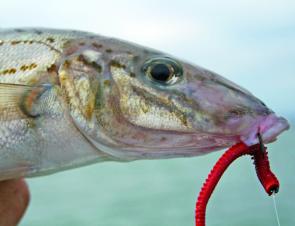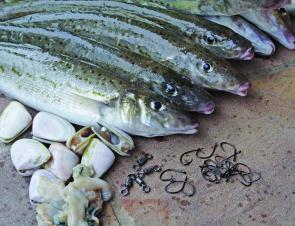King George whiting are one of the most highly sought after species in Western Port. Known for their delicious tasting flesh and fighting capabilities, whiting can at times prove difficult to catch.
Traditionally, whiting anglers have used small long-shanked hooks, enabling them to strike when the bite is detected, which aids in setting the hook. Striking at whiting when using long-shanked hooks is vital to secure a solid hook-up. Those who use long-shanked hooks usually fish for them using nibble tip rods, which have an extremely sensitive tip. This allows the angler to see the smallest of bites before striking.
Technology is always changing, however, and the long-shanked hook in the tackle box of the whiting angler is slowly being replaced by the circle hook.
Circle hooks may only be fairly new to many anglers, but they have been around for hundreds of years. Every day, more anglers are turning to circles because of their success for both hooking and keeping fish on the hook – providing they are fished in the correct manner.
The term circle hook can be applied to a range of designs. Circle hook models have a point that turns mildly inward toward the shank. A true circle hook snags nothing at all, even if placed in your pocket – this is also the same when it enters a fish’s mouth.
Many hook manufacturers make some version of a hook resembling a circle. Each has their unique trait that they consider to be the best.
While each angler has their favourite hook brand, I’m fond of Black Magic’s 1/0 KL, Owner’s Mutu Light Circle #6 and Gamakatsu’s Shiner #6. These particular models are not too thick in gauge and very small in size, making them an ideal whiting hook. Each of these hooks is chemically sharpened and rust resistant.
Baiting circle hooks can prove a challenging task, especially when using harder baits. While most whiting anglers twist on the humble pipi, pinning Bass yabbies, pilchard fillets and small crabs can require a little more attention.
When baiting circles with harder baits, take your time to gently thread them on the hook. Bass yabbies are best when used as live baits, so neatly tuck the hook into the tail enabling the hook point to protrude through the top; this also applies to threading on small crabs.
Pilchard fillets are much simpler; they can be threaded on with a more weaving method so the fillet is worked right to the eye of the hook. This will keep it on the hook, and when a whiting eats it they won’t just suck it off.
Pipi and mussel baits are the easiest to thread on, they can be twisted and wrapped around the entire hook leaving a small amount of hook point exposed for a cleaner hook-up.
If you find your pipi or mussel baits are being sucked off, you can always wrap a little bait elastic around the bait to keep it attached to the hook.
Quite often, you will attract a school of whiting to your location, whether you’re using berley or not. Occasionally you’ll hook a fish, only to lose it shortly after the hook-up. Then you’ll find that the fish have gone off the bite.
This could be simply because the slack tide has approached but, more commonly, it will be because the dropped fish has swum back to the school and spooked them off. I have found that if you lose a fish mid-water, the school stays around, but if you lose it within the first few seconds of the hook-up the school is spooked and you have to make a move to find them again.
When using circles, once the fish is hooked it has a much less chance of getting free, providing you keep a tight line. Clearly this eliminates all possibility of it swimming back to the school and spooking them.
There is a specific way to use circle hooks to maximise the hook-up rate. Anglers wanting to try circles need to be aware that they are best used in conjunction with braided fishing lines. Monofilament lines have too much stretch, which doesn’t allow the hook to be set correctly. You will find best success when using braided lines as they have no stretch and enable the hook to be set the instant the bait is completely swallowed.
What happens with circles is that when the fish takes the bait into its mouth and turns its head to swim off, the hook is pulled back out toward the mouth. As it does so, the hook rotates around and the point enters the side of the mouth protruding through the skin. Circle hooks almost always hook the fish right in the corner of the mouth. Gut-hooked fish are almost unheard of, which is great for releasing fish unharmed.
When the angler sees the rod tip quiver, he or she can begin to fight the fish to the boat - remembering not to give the fish any slack. If there is any slack given, the hook can roll out and you’ll lose your fish, but if you battle the fish to the surface with a tight line you’ll soon boat many more fish than you’ll lose.
Over the past few decades, we have all been taught to strike when noticing a bite on the end of our lines. Though this works well when using conventional suicide, baitholder or long-shanked hooks, it definitely doesn’t with circles.
I guarantee that if you strike at a fish while using circle hooks, you will pull the hook right out of the fish’s mouth 99% of the time. This is because unless the fish is allowed to turn and move off, the hook is unable to rotate around and pin the corner of the fish’s mouth.
The best way to fish with circle hooks, then, is to have your rods set up in rod holders with the drag set. Sit on your hands if you have to, but don’t touch the rods until they are loaded with the weight of a fish. I repeat, do not strike!
Although the standard method for fishing circles is to thread on a bait, soft plastics can also be threaded onto circle hooks and used in the same way. Some anglers choose to work the softies like you would any other soft plastic lure, and though this will still catch a fish I tend to leave a rod cast into the berley trail set up with a paternoster rig. On each hook I thread on a Berkley Gulp 6” Sandworm; these softies are deadly on King George whiting.
Though it may sound a little complicated, the concept of fishing circles is simple: Keep a tight line, sit back, relax and watch your rod load.
Facts
TIPS FOR USING CIRCLE HOOKS
1. Use braided fishing lines.
2. Set your drag.
3. Leave a lot of exposed hook point when baiting.
4. Do not strike at the fish.

Circle hooks are a great alternative to using long-shanked hooks for King George whiting.

Soft plastics can also be used on circle hooks.

The author with a pair of whiting caught on small circles.

Pilchard fillets are ideal when targeting big deep-water whiting, and they are easy to rig on circle hooks.

Circle hooks are designed to pierce the lip, which is ideal if you want to release the fish.

When using circle hooks, rods should be left in their holder: the fish isn’t coming off.

Small circle hooks resulted in this good catch of King George whiting.

Colin displays a handful whiting caught on circle hooks.




